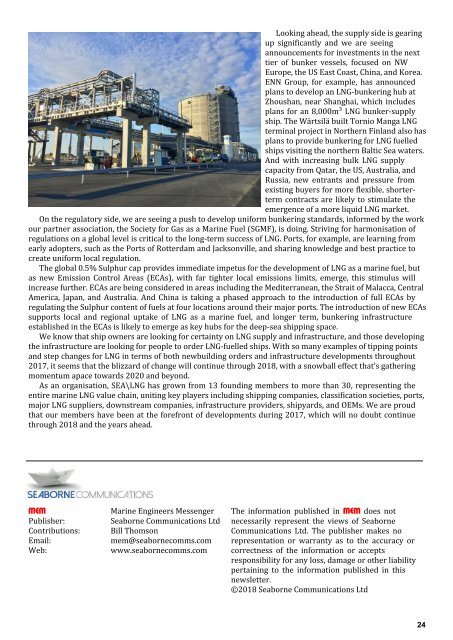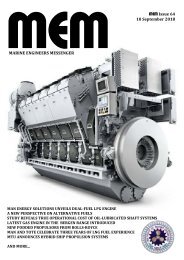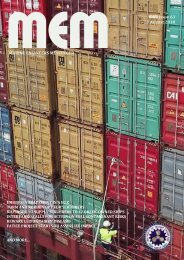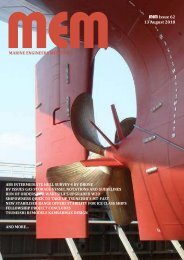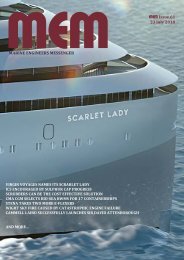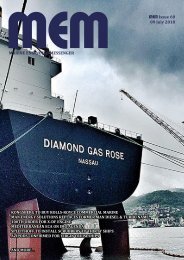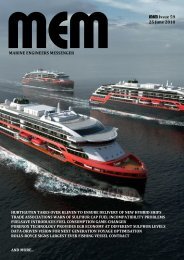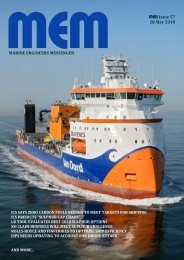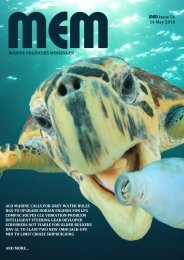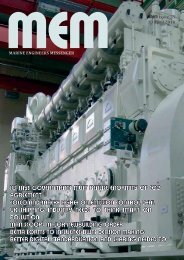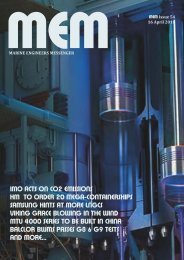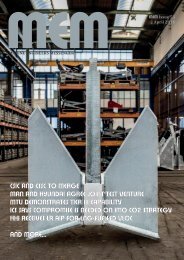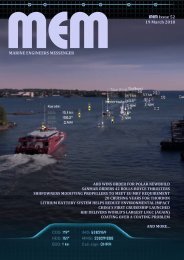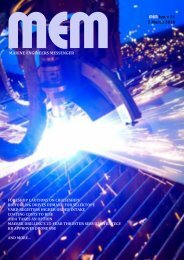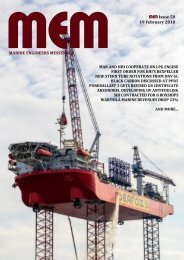MEM47
Marine Engineers Messenger, Volume 3, Issue 47
Marine Engineers Messenger, Volume 3, Issue 47
You also want an ePaper? Increase the reach of your titles
YUMPU automatically turns print PDFs into web optimized ePapers that Google loves.
Looking ahead, the supply side is gearing<br />
up significantly and we are seeing<br />
announcements for investments in the next<br />
tier of bunker vessels, focused on NW<br />
Europe, the US East Coast, China, and Korea.<br />
ENN Group, for example, has announced<br />
plans to develop an LNG-bunkering hub at<br />
Zhoushan, near Shanghai, which includes<br />
plans for an 8,000m³ LNG bunker-supply<br />
ship. The Wärtsilä built Tornio Manga LNG<br />
terminal project in Northern Finland also has<br />
plans to provide bunkering for LNG fuelled<br />
ships visiting the northern Baltic Sea waters.<br />
And with increasing bulk LNG supply<br />
capacity from Qatar, the US, Australia, and<br />
Russia, new entrants and pressure from<br />
existing buyers for more flexible, shorterterm<br />
contracts are likely to stimulate the<br />
emergence of a more liquid LNG market.<br />
On the regulatory side, we are seeing a push to develop uniform bunkering standards, informed by the work<br />
our partner association, the Society for Gas as a Marine Fuel (SGMF), is doing. Striving for harmonisation of<br />
regulations on a global level is critical to the long-term success of LNG. Ports, for example, are learning from<br />
early adopters, such as the Ports of Rotterdam and Jacksonville, and sharing knowledge and best practice to<br />
create uniform local regulation.<br />
The global 0.5% Sulphur cap provides immediate impetus for the development of LNG as a marine fuel, but<br />
as new Emission Control Areas (ECAs), with far tighter local emissions limits, emerge, this stimulus will<br />
increase further. ECAs are being considered in areas including the Mediterranean, the Strait of Malacca, Central<br />
America, Japan, and Australia. And China is taking a phased approach to the introduction of full ECAs by<br />
regulating the Sulphur content of fuels at four locations around their major ports. The introduction of new ECAs<br />
supports local and regional uptake of LNG as a marine fuel, and longer term, bunkering infrastructure<br />
established in the ECAs is likely to emerge as key hubs for the deep-sea shipping space.<br />
We know that ship owners are looking for certainty on LNG supply and infrastructure, and those developing<br />
the infrastructure are looking for people to order LNG-fuelled ships. With so many examples of tipping points<br />
and step changes for LNG in terms of both newbuilding orders and infrastructure developments throughout<br />
2017, it seems that the blizzard of change will continue through 2018, with a snowball effect that’s gathering<br />
momentum apace towards 2020 and beyond.<br />
As an organisation, SEA\LNG has grown from 13 founding members to more than 30, representing the<br />
entire marine LNG value chain, uniting key players including shipping companies, classification societies, ports,<br />
major LNG suppliers, downstream companies, infrastructure providers, shipyards, and OEMs. We are proud<br />
that our members have been at the forefront of developments during 2017, which will no doubt continue<br />
through 2018 and the years ahead.<br />
MEM Marine Engineers Messenger<br />
Publisher: Seaborne Communications Ltd<br />
Contributions: Bill Thomson<br />
Email: mem@seabornecomms.com<br />
Web: www.seabornecomms.com<br />
The information published in MEM does not<br />
necessarily represent the views of Seaborne<br />
Communications Ltd. The publisher makes no<br />
representation or warranty as to the accuracy or<br />
correctness of the information or accepts<br />
responsibility for any loss, damage or other liability<br />
pertaining to the information published in this<br />
newsletter.<br />
©2018 Seaborne Communications Ltd<br />
24


